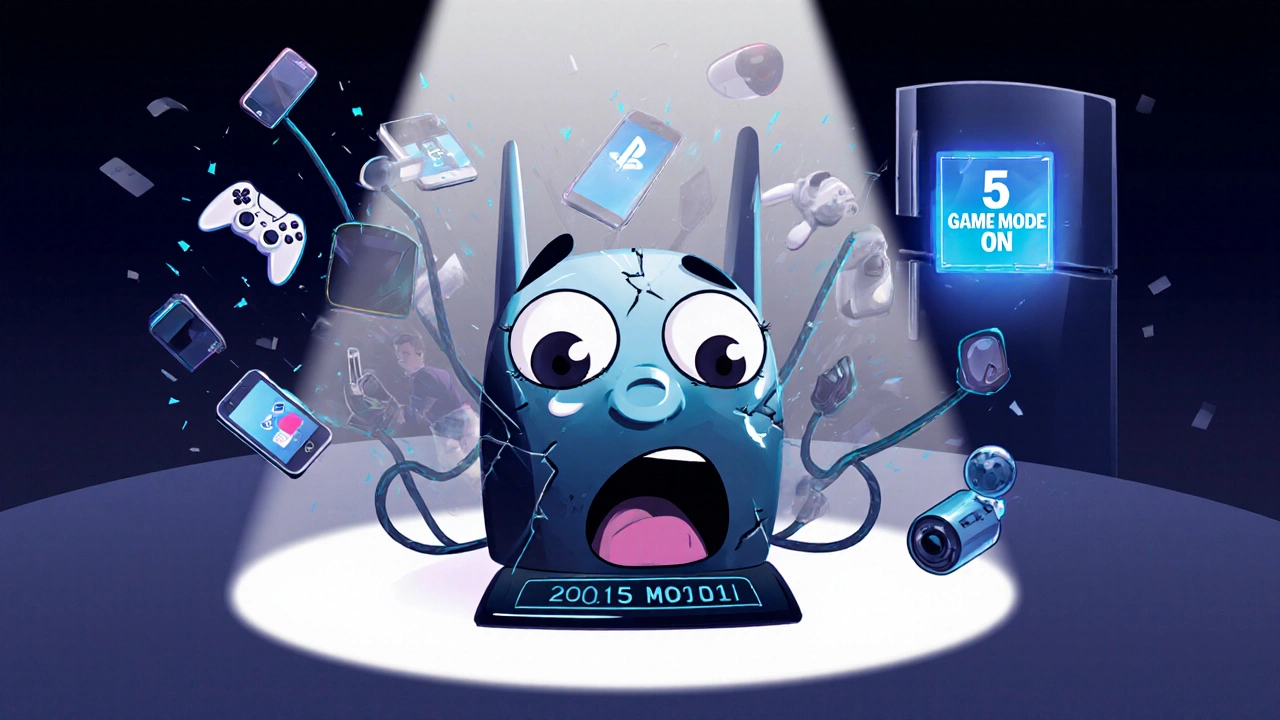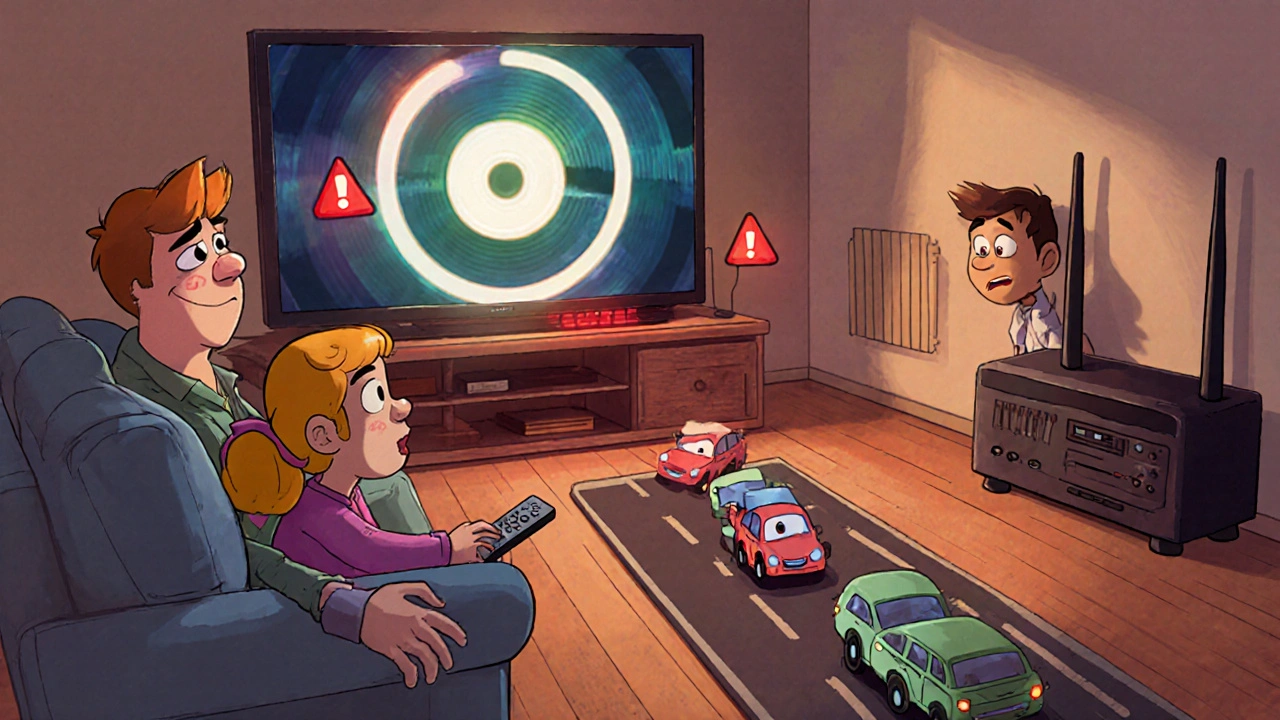You’ve hit play. The screen goes black. Then nothing. Five seconds later, the show starts-but it stutters. Audio lags behind the video. Every few minutes, the spinning circle appears. You’re not alone. Millions of people deal with streaming lag every day, and it’s not always your internet’s fault.
Why Your Streaming Service Keeps Buffering
Streaming lag doesn’t happen because the service is broken. It happens because something between your device and the server is struggling. The most common cause? Your home network. Not your Wi-Fi router, not your ISP-but how data flows through them.
Think of your internet like a highway. Your streaming app wants to send 10 cars (data packets) per second to your TV. But if your router only lets 4 cars through at a time, the rest pile up. That’s buffering. Even if your internet speed is 100 Mbps, if your router is old or your Wi-Fi signal is weak, you’re still stuck in traffic.
Other causes include:
- Too many devices using the network at once (kids gaming, someone downloading updates, smart fridge syncing)
- Using Wi-Fi instead of Ethernet, especially if you’re far from the router
- Outdated firmware on your router or streaming device
- Server overload on the streaming platform during peak hours (yes, Netflix and Disney+ crash too)
- ISP throttling-some providers slow down streaming traffic to save bandwidth
How to Test Your Streaming Speed for Real Results
Running a speed test doesn’t mean much if you’re not testing under the right conditions. Most people run a speed test on their phone while sitting on the couch. That’s useless if your TV is in the living room, three walls away.
Here’s how to get real data:
- Connect your streaming device (Fire Stick, Roku, Apple TV) directly to your router using an Ethernet cable. If you can’t, move the device right next to the router.
- Turn off every other device on your network-phones, laptops, smart speakers, baby monitors.
- Go to speedtest.net on a computer connected to the same network.
- Run the test. Look for download speed and latency.
- Repeat the test while streaming. If your download speed drops below 15 Mbps, you’ll get lag on HD. For 4K, you need at least 25 Mbps.
If your speed is fine when no one else is using the network but drops when your partner starts streaming on their phone, you’ve found the problem: network congestion.
Fix Your Router Before You Buy Anything New
Most people blame their ISP or the streaming app. But 70% of lag issues come from the router. If yours is older than 2020, it’s probably the culprit.
Old routers use outdated Wi-Fi standards (802.11n or earlier). They can’t handle modern traffic. They also don’t support dual-band or tri-band frequencies. That means your smart TV is stuck on the crowded 2.4 GHz band, where microwaves, baby monitors, and Bluetooth devices interfere.
Do this now:
- Log into your router’s admin page (usually 192.168.1.1 or 192.168.0.1-check the sticker on the router)
- Find the Wi-Fi settings
- Switch your TV and streaming devices to the 5 GHz band
- Change the channel from Auto to 36, 40, 44, or 48 (less crowded in most homes)
- Update the firmware if an update is available
Some routers have a "Game Mode" or "Streaming Mode." Turn it on. It prioritizes traffic for video over downloads.

Streaming Device Problems Are Often Overlooked
Your Roku or Fire Stick isn’t just a box. It’s a mini-computer. If it’s running slow, your stream will stutter-even with perfect internet.
Here’s what to check:
- Restart the device. Unplug it for 30 seconds. Plug it back in.
- Clear the cache. On Roku: Settings > System > Advanced system settings > Memory > Clear cache. On Fire Stick: Settings > Applications > Manage Installed Applications > [App Name] > Clear Cache.
- Update the device software. Outdated software causes crashes and delays.
- Remove unused apps. Every app running in the background uses memory.
- Don’t use cheap, no-name streaming sticks. Stick with Roku, Amazon, Apple, or NVIDIA Shield. They have better processors and memory.
I’ve seen people spend $200 on a new TV and use a $15 Fire Stick from a discount store. The TV can do 4K HDR. The stick can barely handle 1080p without lag. You’re paying for the wrong part of the system.
ISP Throttling Is Real-Here’s How to Spot It
Some internet providers intentionally slow down streaming traffic. They don’t tell you. They just make it harder to watch Netflix without buffering.
How to test for it:
- Run a speed test while streaming normally.
- Turn on a VPN (any free one like ProtonVPN or Windscribe will do).
- Run the same speed test while streaming.
If your speed jumps up when the VPN is on, your ISP is throttling you. That’s because VPNs encrypt your traffic, so your provider can’t tell you’re streaming Netflix.
Long-term fix? Switch to an ISP that doesn’t throttle. In Ireland, providers like Vodafone, Eir, and Sky Broadband have better policies. Check their terms for "zero-rating" or "traffic management" clauses.

When to Upgrade Your Internet Plan
You don’t need 1 Gbps to stream Netflix. But you do need enough bandwidth to handle your whole household.
Here’s a simple formula:
- One HD stream = 5 Mbps
- One 4K stream = 25 Mbps
- One video call = 3 Mbps
- One online game = 6 Mbps
If you have three people streaming HD, one gaming, and one on Zoom, you need at least 5 x 3 + 6 + 3 = 24 Mbps. Add a 20% buffer. That’s 30 Mbps minimum.
Most plans in Ireland offer 100 Mbps or more. If you’re on a 50 Mbps plan and still lagging, the problem isn’t your plan-it’s your network setup.
Quick Fixes That Actually Work
Need a fix right now? Try these:
- Lower the video quality. Go into Netflix or Disney+ settings and switch from Auto to 720p or 1080p. You’ll lose some sharpness, but the stream will stay smooth.
- Download shows overnight. Most apps let you download for offline viewing. Do this when your network is quiet.
- Use a Wi-Fi extender only if you’re far from the router. But avoid cheap extenders-they make lag worse. Use a mesh system like TP-Link Deco or Google Nest Wifi instead.
- Plug your streaming device into a different HDMI port. Some TVs have one port that handles video better than others.
- Disable automatic updates on your TV and streaming device. Updates during playback cause crashes.
What to Do If Nothing Works
If you’ve tried everything and you’re still stuck:
- Test with a different streaming device. Borrow a friend’s Roku or Apple TV. If it works, your device is broken.
- Test with a different TV. Connect your streaming stick to a different screen. If it’s smooth, your TV’s HDMI port or internal processor is the issue.
- Call your ISP and ask them to run a line test. Ask specifically if they’re throttling streaming traffic.
- Reset your router to factory settings. Write down your Wi-Fi name and password first. Then reconfigure it from scratch.
Don’t upgrade your internet plan until you’ve ruled out the other causes. Most people spend money on faster speeds when they just need a better router or a reboot.
Why does my streaming lag only at night?
Nighttime lag is usually caused by network congestion. That’s when everyone in your home is streaming, gaming, or downloading. Neighbors using the same Wi-Fi channel can also cause interference. Try switching your router to a less crowded channel (like 36 or 48) or use Ethernet for your main streaming device.
Does 5G home internet fix streaming lag?
5G home internet can help if your current connection is slow or unreliable. But if your router is old or your Wi-Fi setup is poor, 5G won’t solve the lag. The problem isn’t always the internet-it’s how the signal gets from your router to your TV. Make sure your 5G router supports dual-band Wi-Fi and has good range.
Can a powerline adapter fix streaming lag?
Powerline adapters can help if you can’t run an Ethernet cable and your Wi-Fi is weak. But they’re not perfect. They depend on your home’s electrical wiring. If your wiring is old or you have a lot of appliances on the same circuit, they can cause interference. Use them only as a last resort, and choose models with Gigabit Ethernet ports.
Why does my streaming pause every 30 seconds?
This usually means your internet connection is unstable. The stream starts, downloads a few seconds of data, then stalls because the connection drops or slows. Check for interference, switch to 5 GHz Wi-Fi, or use Ethernet. Also, disable any background downloads or cloud backups on other devices.
Is streaming lag worse on Netflix than on Apple TV+?
Not really. All major services use similar tech. But Netflix has more users, so its servers get overloaded during peak hours. Apple TV+ has fewer users, so it’s often smoother. But if your network is the issue, you’ll see lag on all platforms. The service doesn’t cause the problem-it just shows it.
If you’re still having trouble after trying all these steps, it’s time to consider a new router or professional network setup. But don’t rush to buy expensive gear. Most lag problems are solved with a reboot, a better channel, or a wired connection. You don’t need a new subscription-you need a smarter setup.

